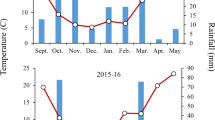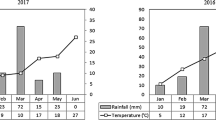Abstract
The ratio of monounsaturated oleic fatty acid to polyunsaturated linoleic fatty acid (O/L) and the associated agronomic traits were profiled for local peanut (Arachis hypogaea L.) cultivars and accessions in Botswana. The research was tested on 16 entries planted in four localities across the country. The average total oil yield of the genotypes studied was about 42.1% and there was no significant difference in total oil yield (P < 0.05) across the four research sites and among all entries (accessions). The average mean O/L ratio for all entries was about 1.47. The highest was that of the locally improved variety, Peolwane (2.58), which was significantly different (P < 0.05) from all other accessions, and the lowest is that of the local accession GO 63 (1.23). This study also profiled the agronomic yield traits to identify genotypes that have both high oil quality and high yielding potential. No correlation was detected between pod yield and O/L ratio among the tested genotypes. The station with little rainfall but adequate repartition showed a very high O/L ratio for some genotypes, and future work is recommended to test this interesting observation on the correlation between moisture stress and oil quality.


Similar content being viewed by others
References
Bockisch M (1998) Fats and oils handbook. AOCS Press, Champaign, pp 174–326
Braddock JC, Sims CA, O’Keefe SK (1995) Flavor and oxidative stability of roasted high oleic acid peanuts. J Food Sci 60:489–493. doi:10.1111/j.1365-2621.1995.tb09809.x
FAOSTAT (2004) FAOSTAT–FAO statistical databases. Food and agriculture organization of the United Nations foreign agricultural service—FAS (2000) Oilseeds markets and trade. Cotton oilseeds, tobacco and seeds division, USDA
Gorbet DW, Knauft DA (1997) Registration of ‘SunOleic 95R’ peanut. Crop Sci 37:1392
Holmback J (2000) Lipid structure and NMR spectroscopic properties, magnetic moments—NMR spectroscopy in lipid science. PhD Dissertation, Royal Institute of Technology, Stockholm, Sweden, pp 23–25
Knauft DA, Gorbet DW, Norden AJ (1995) SunOleic 95R peanut. FL Agric Exp Stn Cir:S–398
Lopez Y, Smith OD, Senseman SA, Rooney WL (2001) Genetic factors influencing high oleic acid content in Spanish market-type peanut cultivars. Crop Sci 41:51–56
Moore KM, Knauft DA (1989) The inheritance of high oleic acid in peanut. J Hered 80:252–253
Norden AJ, Gorbet DW, Knauft DA (1987) Variability in oil quality among peanut genotypes in the Florida breeding program. Peanut Sci 14:7–11
O’Byrne DJ, Knauft DA, Shireman RB (1997) How fat monosaturated rich diets containing high 5 oleic peanuts improve serum lipoprotein profiles. Lipids 32:687–689. doi:10.1007/s11745-997-0088-y
Rahman SM, Takagi Y, Kubota K, Miyamoto K, Kawakita T (1994) High oleic acid mutant in soybean induced by X-ray irradiation. Biosci Biotechnol Biochem 58:1070–1072
Renaud S, De Lorgeril M, Delaye J, Guidollet J, Jacquard F, Mamelle N et al (1995) Cretan Mediterranean diet for prevention of coronary heart disease. Am J Clin Nutr 61:1360s–1367s
Sanders TH (1980) Effects of variety and maturity on lipid class composition of peanut oil. J Am Oil Chem Soc 57:12–15
Soldatov KI (1976) Chemical mutagenesis in sunflower breeding. In: Proceedings of 7th international sunflower conference, Krasnodar, Russia, International Sunflower Association, Vlaardingen, Netherlands, 27 June–3 July 1976
Stoutjesdijk PA, Hurlstone C, Singh SP, Green AG (1999) Genetic manipulation for altered oil quality in Brassica. In: Wratten N et al (ed) Proceedings of 10th International Rapeseed Congress, Canberra, Australia, CD ROM, 26–29 Sept 1999
Velasco L, Nabloussi A, De Haro A, Fernández-Martínez JM (2003) Development of high-oleic, low-linolenic acid Ethiopian mustard (Brassica carinata) germplasm. Theor Appl Genet 107:823–830. doi:10.1007/s00122-003-1295-z
Wright A (1995) A gene conditioning high oleic maize oil, OLC1. Maydica 40:85–88
Acknowledgements
We thank the Department of Agricultural Research of Botswana and the Department of Chemistry of the University of Botswana for jointly funding the research project. We greatly appreciate Ms. Catherine B. Makwala for her supportive work both in the field and with laboratory data collection.
Author information
Authors and Affiliations
Corresponding author
Rights and permissions
About this article
Cite this article
Kassa, M.T., Yeboah, S.O. & Bezabih, M. Profiling peanut (Arachis hypogea L.) accessions and cultivars for oleic acid and yield in Botswana. Euphytica 167, 293–301 (2009). https://doi.org/10.1007/s10681-008-9852-9
Received:
Accepted:
Published:
Issue Date:
DOI: https://doi.org/10.1007/s10681-008-9852-9




